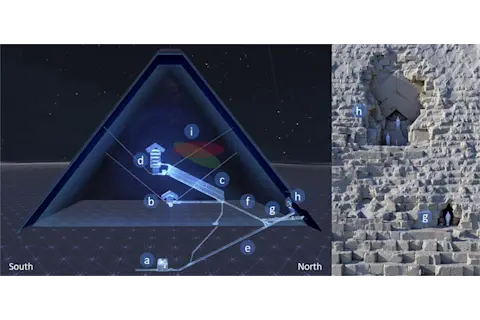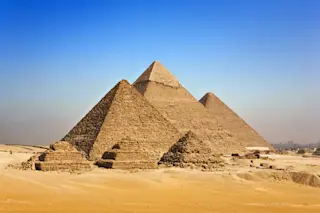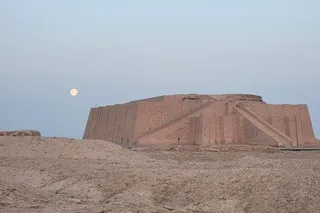For more than 4,300 years, the Great Pyramid of Giza was the tallest human-made structure on Earth. Standing 481 feet, the Great Pyramid lost its title of the tallest in the world after the completion of the Washington Monument in 1885. Today it stands at about 450 feet after losing about 31 feet from the top.
The Great Pyramid has long fascinated scholars, scientists and amateur Egyptologists. As old as it is, much of the Great Pyramid remains a mystery. Now new technologies are helping scientists learn more about the pyramid's inner structure.
In recent years, non-invasive technology has helped researchers discover a 30-foot corridor within the pyramid. Although they don't know the purpose of the secret space, they believe there may be others like it.
Peering into Pyramids
In the nineteenth century, scientists began exhuming and excavating Egyptian pyramids. They realized architects designed the pyramids with inner chambers meant to protect the pharaohs and their treasures from looters.
To dig deep into a pyramid risked destroying it, and for more than a century, scientists had to speculate what was inside. However, in recent decades, non-invasive technologies like cosmic-ray detectors and infrared thermography have been helping researchers to peer into pyramids without causing damage.
In a 2023 study in Nature, an international team of researchers from Egypt, France and Japan revealed more details about a hidden, 30-foot corridor. The corridor is about six feet wide and sits above the main entrance by the pyramid's north face.
The research team is part of the ScanPyramids project, and in 2016 and 2017, they first identified the presence of the corridor and another empty space they dubbed "the Big Void."
The pyramid builders may have designed the corridor as a way to distribute weight and prevent the pyramid from collapsing. They aren't sure what lies beyond the end of the corridor, and even though no one has stepped inside the tunnel for thousands of years, researchers believe the design was intentional.
Read More: Are the Egyptian Pyramids Aligned with the Stars?
Secret Spaces
The ScanPyramids teams took the divide-and-conquer approach to see inside the pyramid. Two Japanese teams went into known chambers beneath the corridor to better understand its shape. A French team worked from the outside.
They each used a type of cosmic-ray muon detector to determine how many muons the structure absorbed. A lower amount of muons would indicate the rock was heavy and dense. A higher amount of rays meant there wasn't anything to obstruct the rays from passing through.
After the teams compared their results and determined the extent of the space, they received permission to push an endoscopic camera through a crevice and into the corridor.
The workers who built the pyramid were the last people to see inside the corridor. However, the video footage provided a rare glimpse inside the hidden chamber and revealed how it was shaped.

(Credit: Nature Communications (Nat Commun) ISSN 2041-1723 (online)) A. Subterranean chamber, B. queen’s chamber, C. grand gallery, D. king’s chamber, E. descending corridor, F. ascending corridor, G. al-Ma’mun corridor, H. north face Chevron area, I ScanPyramids Big Void with horizontal hypothesis (red hatching) and inclined hypothesis (green hatching) as published in November 2017 (Morishima, K. et al. Development of nuclear emulsion for muography. Ann. Geophys. 60, 0112 (2017).). All these images were obtained from a 3D modelization using dedicated laser surveys and photogrammetry data.
Nature Communications (Nat Commun
The roof is chevron-shaped, similar to the entrance below, and the walls are unfinished. The unfinished walls may indicate the corridor was never meant to be seen.
Uncovering History
King Khufu, son of King Snefru, commissioned the construction of the Great Pyramid around 2570 BC during the Fourth Dynasty. It's positioned southwest of what is now Cairo and was built using several million pieces of limestone.
Historians increasingly reject the Ancient Greek assumption that forced laborers built the pyramid. Instead, they are proposing the pyramid was built by skilled laborers who considered it an honor to work on the king's memorial. These workers learned from previous dynasties' pyramid problems and successes. Some utilized stabilizing corridors. Others created underground chambers. The Great Pyramid includes both.
Read More: Who Built the Egyptian Pyramids? Not Slaves
In 1970, a Nobel Prize-winning physicist, Luis W. Alvarez, proposed using cosmic-ray muon detection to see inside the ancient pyramids. The technology has indeed helped scientists confirm the presence of intentional but hidden spaces.
The presence of both hidden rooms has the potential to tell engineers more about how the structure was built. And there was also the possibility a corridor might lead to a hidden chamber with antiquities that could tell historians more about ancient life in Egypt.















